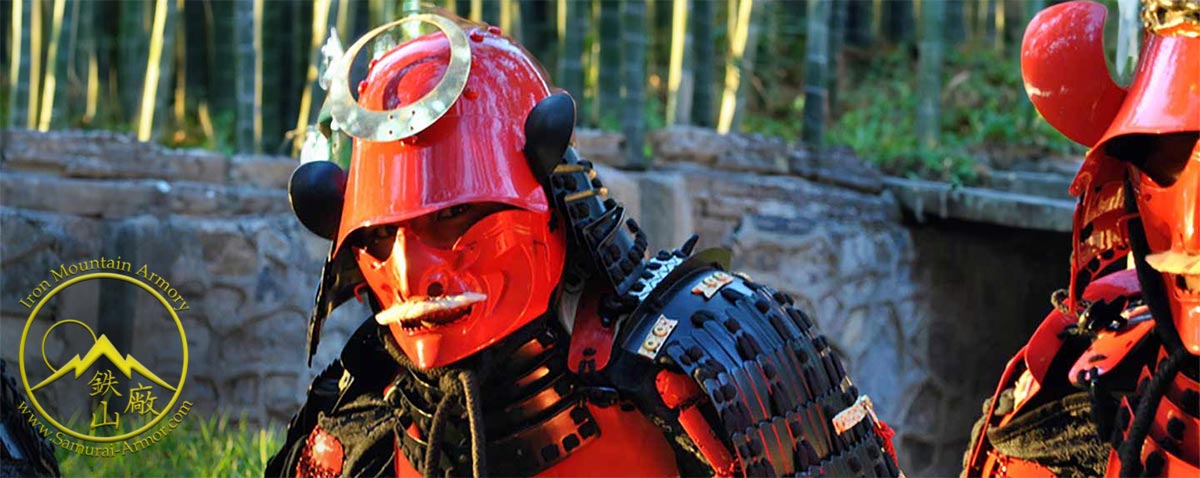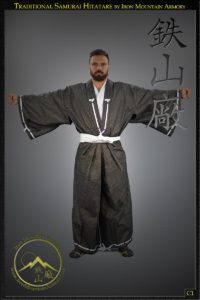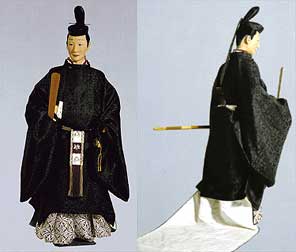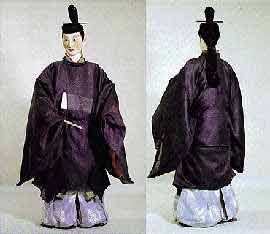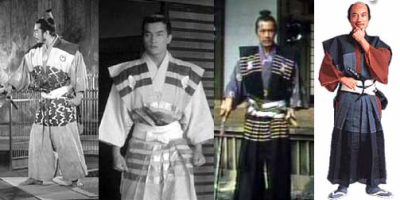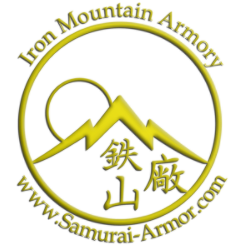Embark on a journey through the folds of time, where fabric becomes a vessel for cultural whispers and tradition threads its way through the ages. Welcome to “Threads of Time: A Poetic Journey Through the Kimono’s Tale,” a captivating exploration of the iconic Japanese garment, the kimono. In this poetic odyssey, we unravel the intricate tapestry of history, tracing the evolution of the kimono from its humble origins in the Nara period to its present-day role as a silent witness to ceremonial moments.
As we traverse the Heian epoch, witness the birth of the kimono’s distinctive form through the enchanting dance of “chokusendachi,” where fabric defies mortal curves and becomes a canvas for innovation. The hues of the Heian period echo through the centuries, celebrating a symphony of color that weaves through political classes and harmonizes with the rhythm of changing seasons.
The Kamakura period invites us to a battlefield transformed into a canvas of individuality, where not just women but men don the vivid hues of the kimono, expressing the kaleidoscope of their souls. In the Edo epoch, witness the kimono’s ascent to artistry, clad in the kamishimo—a linen-clad emblem of clans and a testament to the craftsmanship that elevates the kimono beyond mere attire.
As we journey through the Meiji era, where foreign winds bring whispers of change, and into the present day, where the kimono’s role has evolved, join us in exploring the delicate balance between tradition and modernity. “Threads of Time” invites you to lose yourself in the poetry of fabric, where every fold and hue tells a tale of cultural richness, familial legacy, and the timeless beauty of the kimono.
Nara period
In the tapestry of time, the Nara period unveiled a garment, a symphony of fabric known as the “Kimono.” A poetic embodiment of tradition, where threads wove tales of ancient elegance. “Kimono,” once a mere term for clothing, metamorphosed into the embodiment of Japanese heritage, a vessel for cultural whispers.
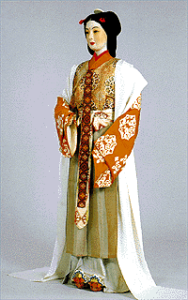
In the embrace of the Heian epoch, the loom of creativity birthed kimonos with a dance called “chokusendachi,” where fabric surrendered to straight lines, defying the curves of mortal forms. Through this, a canvas of innovation unfurled—layers embraced winter’s chill, and summer’s breath was captured in the cool caress of linen. Thus, the kimono became a living part of Japanese existence, a garment rooted in life’s seasons.
In the Heian tapestry, layers donned layers, and hues collided in a celebration of color. Political classes whispered through the kaleidoscope of tones, echoing the rhythm of seasons. A tradition of Japanese color harmony took root, an ode to uniqueness in chromatic poetry.
As time pirouetted from Nara to Heian, a sartorial schism emerged, distinguishing court nobles in restrictive garb and commoners in flowing sleeves akin to Western attire today. A tale of societal stratification woven into the very fabric of existence.
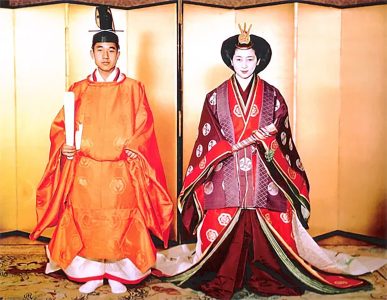
Kamakura Period
Enter the Kamakura period, an era where not only women but also men adorned themselves in vivid kimonos. The samurai, warriors of might, turned the battlefield into a canvas of individuality, their costumes reflecting the kaleidoscopic spectrum of their souls.
Edo Period
In the Edo epoch, under the Tokugawa’s feudal governance, the kamishimo, a linen-clad uniform, became the insignia of clans. Each domain imprinted its identity in patterns, elevating the craft of kimono to an art form. A legacy emerged as kimonos passed through generations, a family heirloom steeped in history.
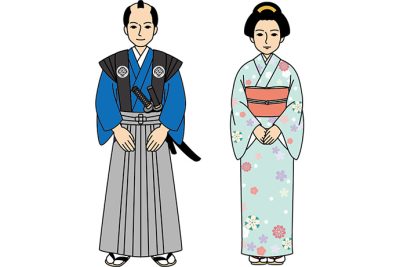
Meiji Period
With the dawn of the Meiji era, foreign winds swept across Japan, carrying whispers of Western influence. Bureaucrats and soldiers donned Western attire, and the common folk were adorned in kimonos, each graced with a “montsuki,” a familial crest, embodying lineage in woven symbols. Formality embraced the kimono, and the threads of tradition intertwined with the changing tides.
Today’s horizon sees the kimono, a rare bloom in the garden of daily life. It adorns ceremonies, a silent poet at weddings and funerals, a regal attire for the academic stage. The dance of fabric persists in the rituals of tea and flower gatherings, a silent echo of summer festivals and Tanabata’s celestial dance. The kimono, a living thread connecting the past to the present, a whispered saga in each fold and hue.
Bukan sokutai (ketteki no sokutai) sugata
Behold the resplendent Bukan Sokutai, a ceremonial dance of tradition and rank in the imperial courts, reserved exclusively for military dignitaries of the fourth court rank and below. Enveloped in the regality of the Ketteki no Hō, the ensemble is a testament to the martial prowess and honor bestowed upon these esteemed men.
At its core, the Bukan Sokutai mirrors its courtly counterpart, the Sokutai Sugata, yet with a distinguished martial flair. The kanmuri, adorning the noble brow, unfurls with a ken’ei, a wrapped tail, and oikake, lacquered horsehair “blinders” perched delicately on the cords. The lacquered leather kanokutsu, a riding boot of refined grandeur, traces the path of these dignitaries as they stride with measured grace.
In this military symphony, a sword, the elegant hosotachi, finds its place off the hirao, a symbol of both duty and honor. Gripped in hands, a bow (yumi) takes center stage, embodying the martial spirit that courses through the veins of these honored men. A quiver, whether the geometric elegance of the hira yanagui or the rounded allure of the tsubo yanagui, cradles arrows adorned with large hawk feather fletchings.
An intriguing detail surfaces—the hanpi, a vest of distinction, becomes an ever-present companion. Its role is paramount, for in the realm of Bukan Sokutai, it is not merely an accessory but a visible emblem through open sides, an echo of martial dignity that cannot be forsaken. As the ceremonial threads weave tales of valor and heritage, the Bukan Sokutai stands as an enduring testament to the fusion of military might and courtly splendor.
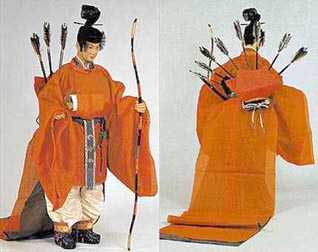
PARTS OF THE BUKAN SOKUTAI:
Garments Shitōzu, (kosode), ōguchi, (ōkatabira), hitoe, akome, uenohakama, shitagasane, hanpi, ketteki no hō.
Accessories Kanokutsu, sekitai, (gyotai), hiraō, tatō, hiogi, shaku, hoso tachi, hirayanagui, yumi, kanmuri.
Bunkan sokutai (hōeki no sokutai) sugata
Enter the grandeur of Bunkan Sokutai, the epitome of courtly elegance worn by civil officials, a sartorial emblem not only of bureaucratic prestige but also gracing the regal presence of the sovereign. This ceremonial attire, donned by men holding civil government appointments and all officials above the fourth court rank, mirrors the majesty of governance itself.
At its heart lies the Hōeki no Hō, the chief ensemble that drapes the wearer in a cascade of ceremonial grace. Yet, in the nuanced details, the Bunkan Sokutai weaves a tale of distinction. The kanmuri, crowned with a suiei, elegantly adorns the head, while the feet are embraced by the refined asagutsu, though whispers of the kanokutsu occasionally find their place in this courtly ballet.
A touch of splendor emerges with the presence of kazaritachi, ornate swords, granted to military officials, counselors (nagon), advisors (sangi), and those bestowed with the Nakatsukasasho’s (Ministry of Central Affairs) coveted permission. Amidst this ceremonial tableau, the hanpi, a vest of significance, occasionally yields to discretion, especially during winter when layers remain concealed beneath the lined Hōeki no Hō. In the heat of summer, however, the hanpi unveils itself, a subtle yet deliberate statement in the sea of black.
Bunkan Sokutai, an attire of governance and grace, encapsulates the essence of civil authority, a symphony of layers and symbols worn not just for the individual but as a living embodiment of the august responsibilities they bear.
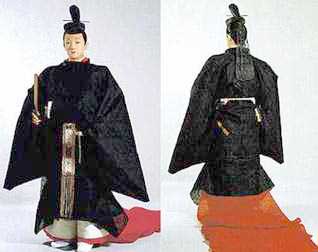
PARTS OF THE BUNKAN SOKUTAI:
Garments Shitōzu, (kosode), ōguchi, (ōkatabira), hitoe, akome, uenohakama, shitagasane, (hanpi), hōeki no hō
Accessories Asagutsu, sekitai, (gyotai), hiraō, tatō, hiogi, shaku, kazari tachi, kanmuri
Dōbuku sugata
In the realm of leisurely elegance, the Dōbuku Sugata emerges as a canvas of individual expression, a garment with no fixed standard, adapting to the whims of personal style and comfort. At home, the wearer may opt for the simplicity of a kosode, or elevate the ensemble by adding the Dōbuku over just the kosode, abandoning the formality of hakama. The zenith of informality, however, lies in the choice to don the kosode alone, an ode to leisure and unrestricted freedom.
A journey through time unveils the Dōbuku’s ubiquity during the Muromachi-Momoyama periods, gracing the bustling streets worn by a diverse cast, from merchants to samurai. Even the court nobles, within the confines of their homes, embraced the Dōbuku, albeit in opulent renditions that whispered tales of extravagance.
Sleeves, or the lack thereof, become mere details in the tapestry of Dōbuku fashion. Samurai, in their distinctive preference, often favored the sleeveless variant, a garment with a slit up the back, mirroring the silhouette of a jinbaori. In this relaxed dance of fabric, distinctions blur, and the Dōbuku becomes a versatile companion, transcending the confines of societal roles.
The Dōbuku Sugata, an embodiment of leisure, stands as a testament to the malleability of style, an attire that invites wearers to weave their narratives in the threads of comfort and personal flair. Whether adorned with sleeves or sleeveless, at home or on the streets, the Dōbuku carries the spirit of leisure, an unfettered expression in the symphony of historical fashion.
PARTS OF THE DŌBUKU SUGATA:
Garments Juban, kosodé, (shitabakama), hakama, dōbuku.
Accessories Waraji, tabi, eboshi, fan, (bladed weapon)
Hakuchō sugata
Enter the realm of simplicity and service with the Hakuchō, a garment steeped in purity and practicality. Crafted from the pristine canvas of white hemp or linen, both upper and lower garments mirror each other, forming a seamless union of attire. The upper piece, akin to the elegant kariginu but slightly abbreviated, boasts sleeves of restrained fullness.
In the dance of fabric, the hakama takes the stage as short kukuri-bakama, a four-panel-width embodiment, cuffs dutifully tied below the knee. A canvas of unlined simplicity, the Hakuchō transcends seasonal distinctions, offering a serene silhouette in both summer’s warmth and winter’s chill.
Deliberately shrouded in the purity of white, the Hakuchō was not just a garment; it was a symbol of servitude. Worn by court servitors, attendants of the kuge and buke, as well as their outrunners and torchbearers on the arduous roads, it became synonymous with those who served with unwavering dedication. So prevalent was this attire among the servants that they themselves became known as Hakuchō.
The ensemble is completed with the humble waraji and a tate eboshi in somber black. The tate eboshi, shorter than its noble counterpart, whispers humility in its fabric, embodying the modesty of those who wear it.
In this garb of service, no weapons find their place, for the Hakuchō is not just an outfit; it is a visual ode to duty, a uniform of humility, a canvas upon which the stories of servitude are woven without the need for embellishments.
PARTS OF THE HAKUCHŌ SUGATA:
Garments kosode, (hitoe), white kukuri-bakama, hakuchō kariginu
Accessories Waraji, small tate eboshi
Hitatare (kamishimo) sugata
Step into the historical tapestry of the Hitatare, an ensemble rooted in the humble origins of everyday wear, evolving over time into a revered attire donned by men of status. Originally, a garment for the common folk, it bore narrow sleeves and hakama, a testament to practicality and thrift in conserving fabric. Yet, as its embrace widened among the elite, the Hitatare underwent a transformation, sleeves billowing and hakama gaining more panels, marking its ascent to a refined status symbol.
In the realm of court nobility, the Hitatare found a companion in the tate eboshi, a dignified headpiece, while the military class adorned the ori eboshi, a samurai’s emblem. Here, harmony reigned as the upper and lower garments became a symphony of matching patterns, fabrics, and cuts, culminating in the elegant kamishimo ensemble.
During the Kamakura period, under the influence of military aesthetics, the Hitatare transcended its origins, becoming the embodiment of leisure for the courtly elite. Simultaneously, for the military, it emerged as standard daywear, a testimony to its versatility. As the sixteenth century unfolded, the kataginu kamishimo took the stage as the new daywear, relegating the Hitatare to a more formal role, replacing the suikan sugata.
In the dance of tradition, military men adorned this attire with tantō or full-sized swords, a symbol of their martial identity. Court nobles, in contrast, often embraced the Hitatare unarmed, embodying a different facet of elegance. It’s worth noting that the Edo period marked the formalization of rules governing the number and type of swords one could wear.
The Hitatare’s versatility was further showcased when worn over armor, a testament to its adaptability in both casual and ceremonial realms. The sleeves, tied elegantly about the elbow, granted freedom of movement, a nod to the practicality inherent in this historical garment. The Hitatare, a journey through time, a tale of evolution and adaptation, an attire that seamlessly wove itself into the fabric of Japan’s rich sartorial history.
PARTS OF THE HITATARE KAMISHIMO:
Garments Juban, kosode, Matching hakama and hitatare.
Accessories Waraji, tabi, eboshi, (bladed weapon)
Hōgo sugata
Enter the realm of Hōko Sugata, a semi-formal ensemble that gracefully bridges the space between official functions and casual occasions, standing a step ahead in formality compared to the ikan sugata. Rooted in simplicity and practicality, its principal garment, the hōeki no hō, bears the weight of tradition, yet with a touch of informality.
The name itself, translating to “cloth hakama,” pays homage to its unique use of shitabakama and sashinuki instead of the more formal silk uenohakama. As a nod to sumptuary restrictions, the Hōko Sugata adheres to a color palette dictated by tradition.
Beneath the hō, the layers echo the grandeur of sokutai sugata, with the outfit technically fitting the definition of sokutai as it employs the sekitai belt. The choice of shitabakama and sashinuki, however, lends a subtle casualness to the ensemble, marking it as the preferred attire for occasions that fall between the spectrum of formality.
In the delicate dance of tradition, the Hōko Sugata often graces the esteemed figures of military officials or men of high rank. The presence of a sword becomes an optional touch, a nod to the wearer’s discretion. As tradition and practicality intertwine, the Hōko Sugata emerges as a canvas of understated elegance, a garment that seamlessly adapts to the nuances of semi-formal occasions with a graceful bow to Japan’s rich sartorial heritage.
PARTS OF THE HŌGO SUGATA:
Garments Shitōzu, (kosode), shitabakama, (ōkatabira), hitoe, akome, uenohakama, sashinuki, shitagasane, (hanpi), hōeki no hō
Accessories Asagutsu (or, sometimes, kanokutsu), sekitai, (gyotai), hiraō , tatō , hiogi, shaku, kazari tachi, kanmuri
Ikan sugata
Step into the nuanced world of the Ikan Sugata, a semi-formal attire delicately nestled just below the grandeur of the Hōgo Sugata, its roots entwined with the ever-evolving currents of Heian-era fashion. Originally a homebound ensemble, this attire found its place within the palace walls around the middle of the Heian period, a testament to its subtle elegance.
The cornerstone of the Ikan Sugata is the ikan no hō, akin to the hōeki no hō but bearing a peculiar duality. It adheres to sumptuary regulations, mirroring the hōeki, yet in its wear and make, it borrows cues from the nōshi. The hakoe, traditionally tucked in, defies convention by being worn out, evoking the spirit of the nōshi. It becomes an ensemble neither fish nor fowl, bridging the realms of hōeki no hō and nōshi with a graceful fusion of cut, fabric, and pattern.
Layers beneath the ikan no hō unveil the potential for a hitoe, a garment echoing the measurements of the sokutai’s hitoe but with diverse fabric choices, ranging from the intricate yokoshigebishi to the simple elegance of unpatterned silk. The hitoe’s hue, dictated by age, weaves a tale—koki iro for the young, moegi for those in their prime, and the serene white or ao for the elderly.
Complementing the ikan no hō is the akome, akin to its sokutai counterpart, but with surface variations in katajiaya or ukiorimono. The idashiginu style, where the front hem peeks beneath the hō, adds a dash of fashion-forward flair.
In the currents of time, the Edo period brought sashiko as a lighter alternative to sashinuki, and the hiōgi gracefully transformed into the familiar vaned ōgi during the Muromachi period. Simplicity defines the Ikan Sugata, with no swords or weapons adorning it. The attire calls for a barefoot elegance, though the elderly and infirm may opt for the comfort of shitōzu.
Known also as “tonoiginu” or “tonoi sōzoku,” the Ikan Sugata stands as a harmonious blend of tradition and personal taste, a semi-formal dance through the corridors of Heian-era elegance.
PARTS OF THE IKAN SUGATA:
Garments (Shitōzu), (juban or kosode) shitabakama, (hitoe), akome, sashinuki or sashiko, ikan no hō
Accessories Asagutsu, tatō , hiogi, shaku, kanmuri
Jikitotsu sugata
Move into the serene elegance of the Buddhist monks’ attire, a manifestation of simplicity and continuity from the mid-Heian through the Edo period—the Jikitotsu-inspired ensemble. With minor stylistic nuances evolving over the years, this outfit retained its common use, a timeless reflection of monkhood.
Rooted in the essence of the jikitotsu, the wearer had the choice to embrace the kukuri-bakama or forgo it, a decision guided by personal preference or the journey at hand. Regardless of this choice, the kyahan, leg coverings, found their place in the ensemble, offering both practicality and a subtle touch of tradition, especially when navigating the roads.
As the fabric of time unfolded, this outfit became a visual testament to the monks’ unwavering commitment to simplicity and spiritual practice. The gentle variations in style merely added layers to the rich tapestry of Buddhist attire. The jikitotsu-inspired garment, a serene companion on the monk’s journey, symbolized a commitment to a life guided by principles rather than material extravagance.
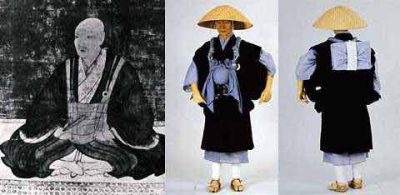
PARTS OF THE JIKITOTSU SUGATA:
Garments kosode, kukuri-bakama, jikitotsu
Accessories Kyahan, kesa, kasa, waraji.
Kachie sugata
Step into the hallowed grounds of duty with the Kachie Sokutai, the revered uniform of the imperial guards when on duty, bearing both the echoes of tradition and the pragmatism of functionality. Named for its principal garment, the kachie, this ensemble holds a distinct identity, despite its superficial resemblance to the bukan sokutai.
In the symphony of attire, the kanmuri takes center stage, its oikake delicately adorned with a hoso’ei, a slender tail that sets it apart from its ceremonial counterpart. Crucial distinctions emerge as the kyo, shitagasane, and akomé gracefully step aside, allowing the essence of practicality to shine through. The formal uenohakama yields to the more utilitarian ōnohakama, a nod to the demands of duty.
Footwear becomes a blend of tradition and functionality, with choices ranging from cloth or hemp shoes like the makai to the rustic straw shoes or boots, the waragutsu. The ensemble, while evoking the essence of bukan sokutai, stands unique in its simplicity and readiness for the duties that lie ahead.
The adornments of a kenukigata tachi or a black-mounted tachi, coupled with the presence of a bow, quiver, and arrows, emphasize the martial nature of the imperial guards. Each element of the Kachie Sokutai speaks to the duality of duty and tradition, a uniform that not only stands as a symbol of imperial protection but also embodies the resilience and preparedness required by those who don it in service.
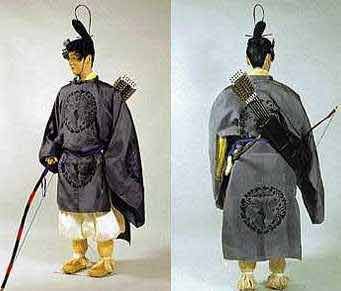
PARTS OF THE KACHIE SUGATA:
Garments (kosode ) hitoe, ōnohakama, hanpi, kachie
Accessories Waraji / makai / waragutsu, ōgi, tachi, tsuboyanagui, yumi, hosoei kanmuri (with oikake), ichibihabaki, shiraobi
Karisōzoku sugata
Embark on a journey into the verdant landscapes of Heian-era horsemanship with the Karisōsoku Sugata, the quintessential hunting outfit that transcended its aristocratic origins to become a virtual uniform for those engaged in the pursuit of hunting and horseback archery. Born within the echelons of the civil aristocracy, its popularity soon spread, finding favor among the military classes by the close of the Heian period.
In its nascent days, those donning the Karisōsoku Sugata faced a choice between the suikan and the hitatare, with the latter gaining preference, particularly among the military elite. This ensemble encapsulated the spirit of equestrian pursuits, a seamless blend of form and function that mirrored the harmonious dance between rider and steed.
As the Edo period unfolded, the suikan, once a stalwart component of the Karisōsoku Sugata, gracefully stepped aside, marking a shift in fashion. The outfit, however, retained its timeless allure, an emblem of the enduring legacy of horsemanship and the pursuit of noble endeavors.
In the symphony of history, the Karisōsoku Sugata stands as a testament to the evolution of equestrian attire, a garment that transcended social boundaries and became a cherished uniform for those who sought the thrill of the hunt and the artistry of horseback archery.
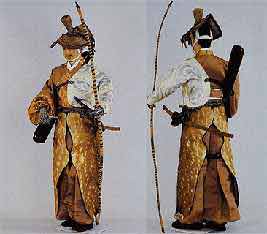
PARTS OF THE KARISŌZOKU SUGATA:
Garments Juban, kosode, hakama, suikan or hitatare, mukabaki
Accessories (Tabi), kutsu, tachi, ebira, yumi, kasa, yugake, igote
Kataginu kamishimo
Step into the resplendent folds of the Kamishimo, an iconic garment synonymous with the samurai class during the Edo period, a testament to the fusion of elegance and functionality. This outfit, comprised of a kataginu and hakama in perfect harmony, echoes the distinct character of the samurai’s attire during this era.
Distinguished by a meticulous match of fabric in color and pattern between the kataginu and hakama, the Kamishimo stands as a hallmark of sartorial refinement. A distinctive feature is the hakama’s waist ties, seamlessly blending with the overall fabric, creating a unified and sophisticated aesthetic.
Two principal forms define the Kamishimo: the pre-1630s model, characterized by its unique charm (captured in the left photos), and the classic Edo period version, exemplified in the right photo. The Edo period witnessed the introduction of nagabakama for more formal occasions, while conventional hakama became suitable for less ceremonial circumstances.
In the historical tapestry, the Muromachi-Momoyama periods witnessed the rise of the kataginu sugata as the typical day-wear for samurai, evolving into the kataginu kamishimo sugata. However, as the Edo period unfolded, this ensemble, once a daily choice, transformed into attire reserved for formal occasions. The kosode and hakama, in their simplicity, took center stage as the daywear of choice.
During the Sengoku and early Edo periods, a kaleidoscope of colors and patterns adorned the Kamishimo, often embellished with the wearer’s mon at strategic locations. The Edo version, however, gravitated towards a more subdued and uniform appearance, marking a shift towards a formal and disciplined aesthetic.
The Kamishimo, an epitome of samurai elegance, carries within its folds the evolution of fashion, from everyday wear to formal regalia, mirroring the changing tides of history.
PARTS OF THE KATAGINU KAMISHIMO:
Garments (Juban), kosode, hakama, kataginu
Accessories Waraji, tabi, (katana) (wakizashi), ōgi, (ori eboshi)
As we conclude this journey through the intricate folds of time and fabric, the Kimono emerges as more than a garment; it is a living testament to the evolution of Japanese culture and tradition. From its humble origins as a term for clothing in the Nara period to the Heian era’s poetic transformation, the Kimono became a vessel carrying the whispers of ancient elegance and the essence of Japanese heritage.
The Heian epoch introduced a dance of creativity, with the “chokusendachi” method shaping the Kimono’s design, defying the limits of form and embracing the nuances of each season. Layers upon layers and a palette of colors celebrated uniqueness, reflecting the political classes and harmonizing with the natural rhythms of Japanese life.
Transitioning through the ages, from the Kamakura period’s vibrant individuality to the Edo period’s kamishimo becoming an art form, the Kimono stood as a symbol of identity and artistic expression. The Meiji era brought Western influence, yet the Kimono endured, adorned with familial crests, weaving threads of the past into the changing currents of time.
In the contemporary landscape, the Kimono remains a rare bloom, gracing ceremonial moments and silently narrating stories at weddings, funerals, and academic milestones. Its dance continues through the rituals of tea ceremonies and flower gatherings, connecting the past to the present—a living thread of whispered sagas in each fold and hue.
As we bid farewell to this exploration, may the Kimono serve as a reminder that tradition is not static but a dynamic tapestry, each fold echoing the resilience of Japanese culture and the beauty woven into the threads of time. The Kimono stands as an enduring symbol, inviting us to appreciate the silent poetry and profound narratives carried within its elegant embrace.
